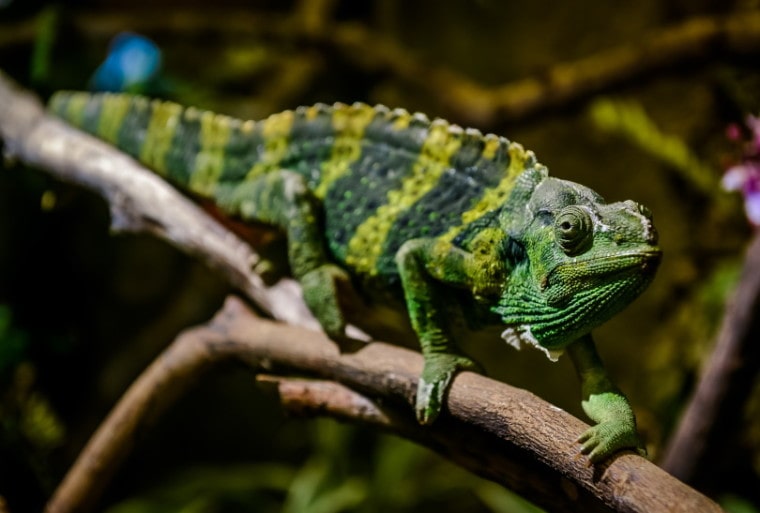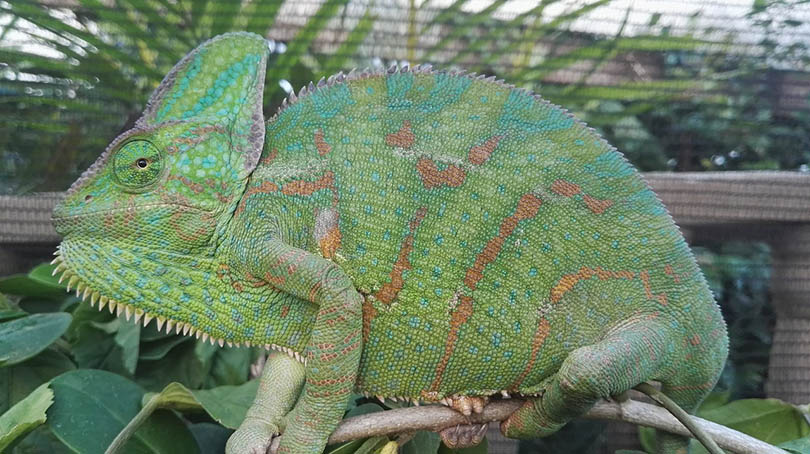
Chameleons are among the most captivating of lizards. They are best known for their ability to change colors and have become a popular choice of exotic pets. In addition to their striking ability to change color, they have a unique body shape, can move each eye 360 degrees independently, and catch prey by projecting their long, sticky tongue.
So which Chameleons change color? The answer is all of them. Most chameleons don’t have a vast variety of color changes and tend to change from brown to green and back to brown. Some species, however, can turn a wide variety of vibrant colors.

The 11 Species of Chameleon With the Most Drastic Color Changes
With most species of chameleons changing colors from various hues of greens and browns, there are some species and sub-species that display more drastic, alluring color-changing capabilities. Below is a list of some of the most vibrant chameleons in both pattern and color:
1. Ambilobe Panther Chameleon

The Ambilobe Panther Chameleon is a sub-species of panther chameleon found in the eastern and northern areas of Madagascar. This is one of the most popular pet chameleons due to having the most vibrant coloration.
The Ambilobe Panther Chameleon can be red with a blue bar, blue with a red bar, green with a blue bar, and can display white and yellow colorations as well.
2. Cape Dwarf Chameleon

The Cape Dwarf Chameleon is a chameleon native to the South African province of the Western Cape. Cape Dwarf Chameleons are mostly green with orange lateral markings on their body and head.
3. Carpet Chameleon

The Carpet Chameleon hails from the woodlands of Madagascar. They are highly regarded as pets for their striking coloration. It has been said that their name comes from their resemblance to an intricately woven oriental carpet.
They have either a green or tan base but when in full coloration they can display patterns of green, white, yellow, orange and red, and even lavender-colored spots. Males tend to display more of a vibrant, lime-green base.
4. Kynsa Dwarf Chameleon

The Knysna dwarf chameleon is a species of dwarf chameleon endemic to South Africa. It is a forest dweller, found only in a limited range surrounding the forests near Knysna, South Africa. This chameleon has a prominent casque and bright green to bluish skin. Their coloration can include purple, yellow, and pink hues.
5. Labord’s Chameleon

Native to Madagascar, the Labord’s Chameleon is the shortest-lived vertebrae. Unlike most species of chameleon, the female’s coloration is more vibrant than the males. The body is patterned with blue and purple marking on its flanks and vibrant orange along the back.
6. Meller’s Chameleon

Also known as the giant one-horned chameleon, this is the largest species of chameleon hailing from Africa’s mainland. Meller’s Chameleons will change color to communicate with others and as a stress response. Their normal appearance is a deep green base that is frequently marked with yellow stripes and black spots.
7. Minor Chameleon

Another example of the few species of chameleon where the females have brighter colors. These chameleons can fare well in captivity but are not widely bred and are banned from being exported out of Madagascar. Their coloration is emerald, green with bright red on the head, they have yellow banding and red and blue spots on the sides.
8. Nosy Be Panther Chameleon

Nosy Be is an island locality off the northwestern coast of Madagascar. Nosy Be Panther Chameleons are a vibrant sub-species of Panther Chameleon with a green, blue, yellow, and red coloration. The end of the mouth is yellow and the body is typically a green base.
9. Parson’s Chameleon

The Parson’s chameleon is a larger species of chameleon, native to the humid forests of northern and eastern Madagascar. Parson’s chameleons stand out with their larger nasal appendages that look gar-like. Parson’s chameleons have a green base and striking orange eyes.
10. Veiled Chameleon

Veiled Chameleons are native to the Arabian Peninsula in Yemen and Saudi Arabia. Also referred to as the cone-head chameleon and Yemen chameleon, they are a very popular species kept as pets. They have a distinct bony protrusion on top of the head, called a casque. They are naturally green with the ability to lighten or darken the hues. They can also display colors red, brown, blue, and yellow.
11. Verrucosus Chameleon

Also known as the warty chameleon, spiny chameleon, or crocodile chameleon, this species is native to Madagascar and has distinct, enlarged scales on their bodies. Males are commonly grayish-brown in color but change to a bright turquoise and vibrant green. A white lateral stripe is displayed when they become stressed.

How Do Chameleons Change Color and Why?
The color-changing aspect of the Chameleon is quite interesting. Their skin has a superficial layer that contains pigments, under that superficial layer are cells with guanine crystals. Chameleons change their color by changing the space between the guanine crystals. When the space changes, the wavelength of light reflected off the crystals changes the colors of the skin.
Scientists have learned that Chameleons can tune into the distances between the crystals in their skin that reflects the light. This process creates a variety of colors that makes them ever so popular.
Chameleons can quickly change their appearance in response to their surroundings, temperature, and mood. Adult males tend to change color more often, especially when they are trying to attract a mate or are in a territorial battle.
Some species can change color in less than 30 seconds but have much less variation, other change slower but have a wider range of colors. Females and younger chameleons tend to have less drastic changes.

Conclusion
Chameleons can make for very interesting pets that are striking to look at. Not all chameleons display drastic color changes but some certain species and sub-species have the incredible capability of reflecting a variety of colors.
Any potential owner will want to look up the care requirements of pet chameleons. You will need to take a look at how they live their lives and do your best to replicate that in their captive environment. They are high-maintenance pets that do not enjoy human interaction and are best just being observed in their enclosure.
Featured Image Credit: Alex Tihonovs, Shutterstock








